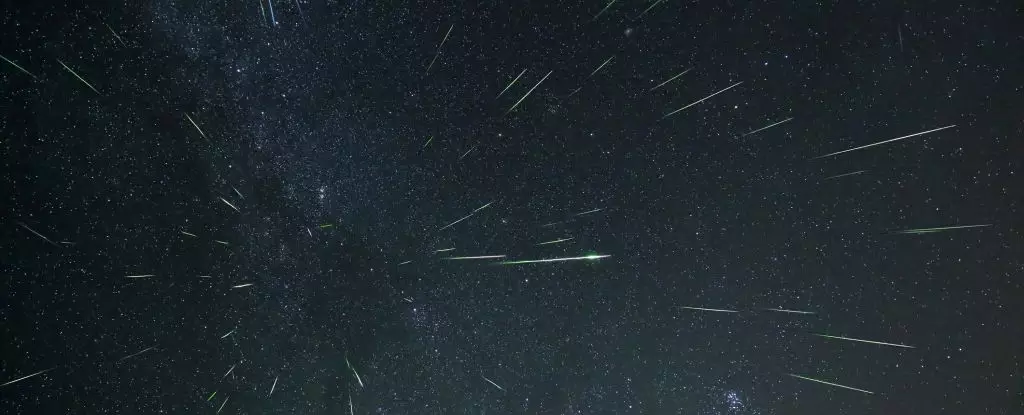As the nights of April and May unfold, sky-gazers are given a unique opportunity to witness two of the most enchanting meteor showers, the Lyrids and the Eta Aquariids. The cosmic dance of these stellar events not only satisfies our primal curiosity about the universe but also connects us to the ephemeral beauty of nature, reminding us of the realities beyond our earthly existence. For everyone from seasoned astronomers to casual stargazers, these meteor showers provide a chance for reflection, wonder, and a deeper understanding of our cosmic home.
The Lyrid Meteor Shower: A Journey Through Time
Kicking off the celestial excitement is the Lyrid meteor shower, which will illuminate the skies from April 17 to April 26. Each year, as we traverse the debris remnants of comet C/1861 G1 (Thatcher), we engage in an age-old ritual of watching shooting stars. The Lyrids, peaking between April 21 and 22, have a historical significance that dates back over 2,600 years. Ancient texts chronicled their beauty, showcasing humanity’s long-standing fascination with the cosmos.
Unlike many other meteor showers, the Lyrids are noteworthy not just for their beauty but for their unpredictable intensity, sometimes producing bursts of activity that can astound observers. While a waning moon threatens to overshadow this year’s display—with only 40 percent visibility—the anticipation of catching a glimpse of these luminous streaks remains high. Optimal viewing conditions necessitate a dark sky and a patient spirit, well-equipped with a cozy spot and warmth for the chilly evenings.
The Eta Aquariids: A Southern Spectacle
Transitioning from the Lyrids, the sky eventually sets itself ablaze once again with the Eta Aquariids from April 20 through May 21, peaking on May 2 and 3. This shower, linked to the infamous Halley’s Comet—known for its rare appearances once every 76 years—excites sky-watchers primarily from the southern hemisphere, where as many as 50 to 60 meteors can be spotted per hour. Such generous displays are a testament to the sheer power of nature, drawing not only avid astronomers but also curious souls who wish to seek solace and inspiration beneath the silent canopy of stars.
On the other hand, the northern hemisphere is not left entirely in the dark; while numbers dwindle to around 20 meteors per hour, the ethereal nature of the moment keeps everyone gazing skyward. The radiant point near the constellation Aquarius serves as a beacon for all, drawing our collective gaze toward something greater than ourselves.
The Allure of Spectacle and Science
What makes these meteor showers truly riveting is their reflection of the elegant chaos of the universe. With every meteor we observe, we are reminded that they consist of tiny fragments, often no larger than a grain of sand, entering Earth’s atmosphere at astonishing speeds, leading to spectacular displays. The very act of watching meteors contrasts extensively with our daily lives, pushing us to ponder the enormity and complexities of time and space.
Moreover, observing these celestial events fosters a sense of community, as strangers huddle together in chilly evenings, sharing stories, hopes, and dreams beneath the starlit sky. It’s an invitation to engage with both nature and our fellow humans—a chance to rekindle our connection with the cosmos that we so often overlook amid worldly distractions.
Preparation is Key: Tips for Optimal Viewing
For those ready to embark on this celestial journey, some practical advice can make all the difference. Finding a location with minimal light pollution is essential. Ideal viewing areas include rural fields, parks, or even rooftops away from city lights. Bring warm clothes, a reclining chair, or a cozy blanket to keep comfortable and allow yourself to relax as you watch the wonders unfold.
Importantly, patience is a virtue. Meteors do not follow a set schedule; sometimes they come in waves, other times sporadically. Allowing the eyes to adjust to the darkness will enhance visibility and reveal the elusive trails of light. As you half-close your eyes and let them wander across the night sky, you’ll find that the experience transcends mere observation, transforming into a meditative moment of wonder and introspection.
So, gear up and prepare to witness the sky’s grandeur during these mesmerizing months, where ephemeral fragments of celestial history dance across your line of sight, inviting you to dream a little bigger.


Leave a Reply